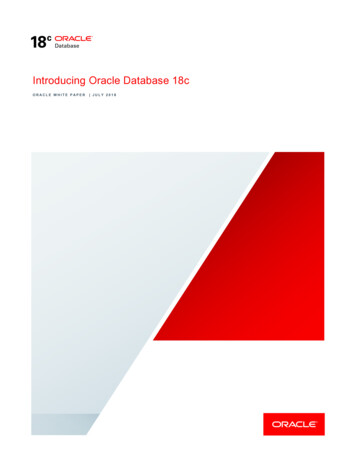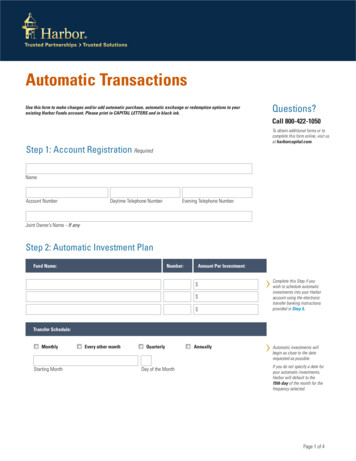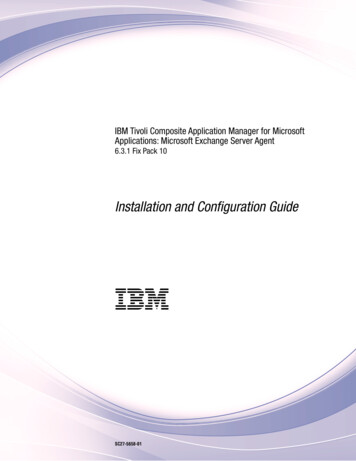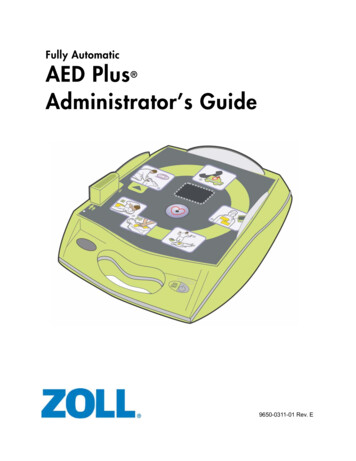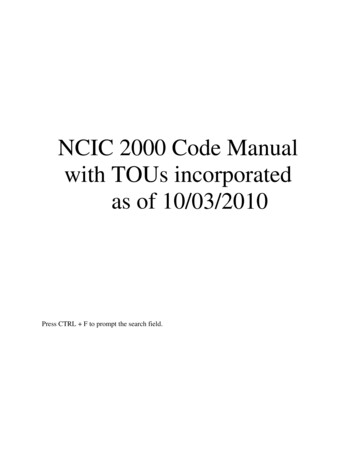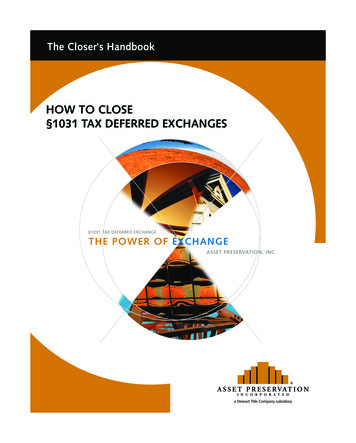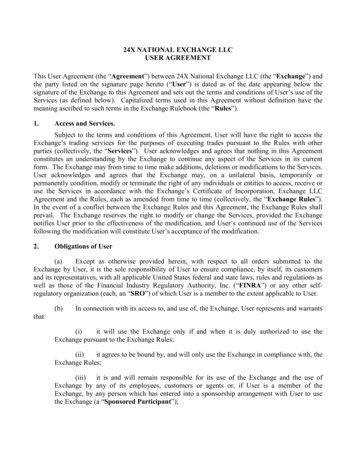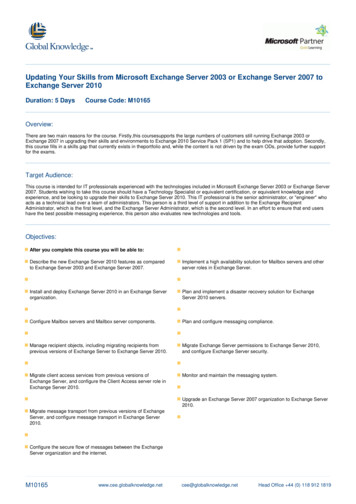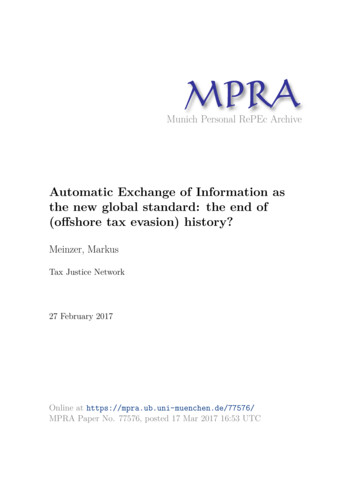
Transcription
Munich Personal RePEc ArchiveAutomatic Exchange of Information asthe new global standard: the end of(offshore tax evasion) history?Meinzer, MarkusTax Justice Network27 February 2017Online at https://mpra.ub.uni-muenchen.de/77576/MPRA Paper No. 77576, posted 17 Mar 2017 16:53 UTC
Automatic Exchange of Information as the new globalstandard: the end of (offshore tax evasion) history?*Author: Markus Meinzer1This Version: 27 February 2017*Working Paper. Submitted for publication in the following edited Volume:Automatic Exchange of Information and Prospects of Turkish-GermanCooperation, Istanbul (ed. Leyla ATEŞ & Joachim ENGLISCH) (forthcoming).Based on a presentation given on 3 March 2016 at the 2nd Turkish-GermanBiennial on International Tax Law in Istanbul.Abstract: Automatic exchange of information (AEoI) for tax purposes hasbecome the global standard for international tax cooperation in 2013. As a toolfor containing offshore tax evasion, it has encountered opposition in the past andcontinues to be fraught with challenges. This paper recapitulates the rationale forAEoI, including estimates on the magnitudes of assets held offshore, with aspecific focus on Turkish assets held in Germany (chapter 1). Subsequently,chapter 2 summarises the recent history and describes the processes andmilestones until breakthrough for global AEoI in 2013. Chapter 3 then discussesthree current challenges, including the de facto exclusion of developingcountries; how to incentivise recalcitrant jurisdictions to participate, such as theUSA; and issues around the implementation of the CRS, including OECD’s GlobalForum of Transparency and Exchange of Information, the peer reviews andpublic statistics. Chapter 4 concludes.Keywords: Offshore Finance, International Cooperation, Money Laundering,Economic Development, Developing Countries, Tax Havens, Secrecy JurisdictionsJEL:1F38, H26, K34, O19, O23, F63, F53, F55, H77Any feedback and comments are welcome: markus@taxjustice.net.1
1. Why Automatic Exchange of Information mattersIncreasing economic inequality and concentration of wealth across the globe isbecoming widely recognised as a, if not the most important, problem of our time.A wide spectrum of actors and organisations, including the World EconomicForum in Davos (Vanham, Peter 2017), academics such as Piketty (Piketty2014), charities such as Oxfam (Oxfam 2016), the OECD (2015), theInternational Monetary Fund (Dabla-Norris et al. 2015) and the United Nationsand its Sustainable Development Goals (High Level Panel 2013: 60), havepointed out the risks and harms caused by current levels and dynamics in incomeand wealth inequality. These range from degrading the environment, reducingeconomic growth and increasing social exclusion to undermining fair marketcompetition and indeed democratic institutions. Societies with lower levels ofincome inequality suffer less from social problems such as crime, mentaldiseases, obesity or teenager pregnancies (Wilkinson/Pickett 2010). Thissuggests that also for the economically better off, more economic equality maybe desirable as they also stand to benefit from a safer society with less crimeand other social problems.While there are multiple causes for inequality, one important causeconsists in the ability of wealthier segments of societies to escape their taxobligations. By shifting financial assets and income offshore – that is, acrossborders, beyond the reach of their tax administrations - they can engage in taxevasion, which directly undermines both the progressive nature of incometaxation and thus the bedrock of modern societies, and redistribution as one ofthe four key functions of taxes (Cobham 2007). It also impacts the voluntarycompliance of all other taxpayers because “[i]f taxpayers believe tax evasion tobe common, tax morale decreases” (Frey/Torgler 2007: 153).Tax havens – or more usefully, financial secrecy jurisdictions – havecommercialised their sovereignty (Palan 2002) to provide a shield of secrecy forthose seeking to hide their fortunes. By creating laws that invite financialinstitutions and service providers to receive, hold and manage the assets of nonresidents without providing information to the relevant home authorities, secrecyjurisdictions facilitate and incentivise the nondeclaration of assets, income and2
capital gains.2 But the problem is not restricted anymore to notorious Caribbeanor Alpine secrecy jurisdictions. Major financial centres such as the United States,the United Kingdom and its empire of overseas satellite jurisdictions as well asGermany all host substantial offshore assets and provide secrecy (Cobham et al.2015; Meinzer 2016).Given the widespread principle of worldwide income taxation rights infavour of the jurisdiction where individuals are resident, offshoring assets andincome constitute illegal tax evasion as long as these assets and income are notdeclared in income tax returns to the relevant domestic tax administration. Inpractice, however, the laws underpinning this principle have hardly beenenforced in practice because the risk of being caught for offshore tax evasion isextremely small, absent any third-party reporting obligations that workeffectively across borders. Without routine reporting by third parties – e.g. byfinancial institutions reporting account balances of clients to the taxadministrations - compliance with tax laws is likely to fall dramatically. Acomprehensive study by the US Treasury’s Internal Revenue Service (2012)analysed the tax gap for the United States – the differences of taxes due and thetaxes actually paid. It allocated the amounts lost due to misreporting of incomeinto categories of income sorted by the intensity of third party reporting. Theresults are striking: when income is subject to substantial information reporting(or high visibility or transparency), only between 1% and 8% of the amounts ismisreported. However, if the income is subject to little or no informationreporting (or little or no transparency), 56% of the income is misreported. Thislatter case is, of course, the context of international business and taxation. Therehas not been a functioning system for routine reporting across borders for thelast decades.These findings suggest that tax evasion of cross-border income is the rule,and not the exception, at least as long as no effective information reporting onthat income is taking place. Other studies and experiences confirm this. Forexample, Gaggero (et al. 2007) estimate that 85% of wealth held abroad bysee Tax Justice Network’s Financial Secrecy Index for a discussion of the full range ofissues involved, e.g. www.financialsecrecyindex.com (Cobham et al. 2015; Meinzer2016).23
Argentineans goes untaxed. A detailed enquiry by the French parliament into theleaked data by HSBC private bank corroborated this finding. Of almost 3000French clients, only six had properly declared the accounts in their tax return – aratio of ca. 0.2% (Assemblée Nationale 2013: 19-20).Important destinations of offshore assets are the United States andSwitzerland. With respect to Switzerland, Helvea (2009) estimated that between80% and 99% of about 2 trillion Swiss Francs invested in Swiss accounts by nonresidents are undeclared. And in Liechtenstein, which is in a customs andmonetary union with Switzerland, in a sample of accounts held by US clientsanalysed by US Justice, only 2% were declared properly in the USA.3 However,the US itself hosts an important offshore asset sector. In a letter to the thenU.S.-Secretary of the Treasury Tim Geithner, Florida delegates to the House ofRepresentatives wrote in 2011:“For more than 90 years, the United States has recognized the importanceof foreign deposits and has refrained from taxing the interest earned bythem or requiring their reporting.[ ] Because of the privacy laws of theUnited States, nonresident aliens are estimated to have deposited over 3trillion in U.S. financial institutions.” (Florida Delegates to the House ofRepresentatives 2011: 1).While the exact amounts at stake are necessarily uncertain given the hiddennature of these activities, there is no doubt that the resulting revenue losses aresubstantial. The lowest estimate of global financial wealth held ‘offshore’ is 7.6trillion in 2013 (Zucman 2014), the highest is 21- 32 trillion in 2010 (Henry2012). Both studies coincide however that the estimated global tax revenuelosses resulting from undeclared offshore assets amount to ca. 190bn annually– most, if not all of which, would be borne by the wealthiest in each society. Thisamount is greater than the sum of all official development assistance paid todeveloping countries in 2013 (US 135 billion).4 For Africa alone, the stock ofoffshore assets that have been accumulated through illegal capital flight between3Liechtensteiner Vaterland, 19.7.2012, S. h.htm; 10.2.2017.44
1970 and 2008 is estimated to amount to US 944 billion. If contrasted with thestock of foreign debt of the same African nations of US 177 billion(Ndikumana/Boyce 2011), it becomes apparent that the African continent is anet creditor to the rest of the world.In the German financial system, the amount of tax exempt interestbearing assets held by non-residents ranged between 2.5 - 3 trillion as ofAugust 2013. Of this sum, an estimated 7.4 billion of interest bearinginvestments in the German financial system has a direct origin in Turkey,including bank deposits, corporate and government debt, as well as interestbearing shares of investment funds.5 When applying the same methodology withupdated data for December 2016, this amount has increased to 10.8 billion (seetable 1 below). Of the total interest bearing assets held by all non-residents inGermany, only ca. 1% was subject to information exchange according to theEuropean Savings Tax Directive in 2013 (Meinzer 2015b: 50). Given that interestincome stemming from those assets would normally be taxable in Turkey6 isunlikely to be reported and taxed, the amounts invested in the German financialsystem by Turkish residents imply a considerable revenue loss to Turkey.Table 1: Interest bearing assets held in German financial system withdirect origin in TurkeyYear/DateBankOf which% ofMultiplierLiabilitiesnon-banknon-bankTotal interestbearing assetsonly (Mio. )(Mio. 3,8582,25258%see above9,778Dec-164,2592,13850%see above10,794Sources: Deutsche Bundesbank 2013b, 2015, 2017, 2014b, 2013a, 2014a;Meinzer 2015; own analysis.5Based on Bundesbank data, for methodology see Meinzer 2015: 48-52;www.chbeck.de/fachbuch/zusatzinfos/Anhang2 Steueroase%20Deutschland.pdf;10.2.2017.6In addition, the assets themselves might be the fruit of domestic tax evasion.Therefore, reporting about the income and assets might trigger further investigationsabout domestic tax evasion as well.5
The findings by the US IRS tax gap study illustrate another important point aboutautomatic information exchange. The main effect expected from automaticexchange of information (AEoI) is a deterrent effect: it is likely to impact thebehaviour of offshore investors prior to the information exchanges taking place.Therefore, the direct revenue impact of AEoI is hard to measure by the numberof additional cases or revenue raised through enforcement activity directlytriggered by AEoI. Rather, investors will adjust their portfolio investmentdecisions and either repatriate assets, relocate or declare them (Meinzer 2010).2. How did we get here? Past challenges in tax informationexchangeThe global financial crisis of 2008 provided the trigger that accelerated a reformprocess which culminated in the implementation and rolling out of automaticinformation exchange pursuant to the OECD’s Common Reporting Standard(CRS). The recent history leading to these events can be categorised in 6 phases(see table 2, below).Table 2: Phases in the recent history of global tax information exchangePeriodPhase2002-2008“Upon request” in Sleeping Beauty2009-2010Rolling out of “upon request”, brewing conflict around AEoI2010-2012Conflict: enter FATCA and Rubik2012-2013Breakthrough for AEoI2013-2014Details of open AEoI framework are unveiled, the battle for scope2015-?:Rolling out, the battle for meta transparency and effective sanctionsThe first phase begun with the demise of the OECD’s harmful tax competition(1998) project, which was effectively blocked by tax havens and their politicalallies. As a result, the OECD invited six notorious tax havens which hadcommitted to improve on transparency to participate in shaping a standard for6
information exchange and transparency. The initial six were Bermuda, CaymanIslands, Cyprus, Malta, Mauritius and San Marino. Soon, this group became theGlobal Forum Working Group on Effective Exchange of Information, andexpanded its membership to include, in addition to OECD and theaforementioned, the following jurisdictions: Aruba, Bahrain, Isle of Man, theNetherlands Antilles, and the Seychelles (OECD 2002: 2). This group developedthe 2002 Model agreement for tax information exchange (TIEA), which wasrestricted to information exchange upon request (ibid.; Meinzer et al. 2009).However, very few TIEAs were signed by notorious tax havens until the globalfinancial crisis hit in 2008 (Misereor 2010: 3).While automatic information exchange was hardly being discussed at theOECD at that time, public discourse and other organisations went further. In2003, the European Union (EU) enacted the first multilateral system forautomatic information exchange through its Savings Tax Directive (Gilligan2003). While limited in scope and riddled with exceptions and loopholes, itestablished an important precedent for the principle of automatically exchangingsensitive bank information across borders. In April 2008, some commentatorswrote in the Financial Times: “We need the automatic exchange of taxinformation between jurisdictions and all developing countries must beincluded”.7 This call was echoed later by Mexico’s Finance Minister AgustinCarstens who said in a letter to U.S. Secretary of the Treasury, TimothyGeithner: "The [automatic] exchange of information on interest paid by bankswill certainly provide us with a powerful tool to detect, prevent and combat taxevasion, money laundering, terrorist financing, drug trafficking and organizedcrime.“ (Carstens 2009; [own addition]).In 2008, a series of public media stories increased the pressure forfundamental reform. The United States Justice Department was investigatingUBS through the insights offered by whistleblower Bradley Birkenfeld, causingmedia headlines and a Senate Probe throughout 2008.8 In February 2008,German tax investigators raided the home of the then CEO of Deutsche Post c90000779fd2ac.html?siteedition intl; 1105859731; 13.2.2017.7
because of his tax evasion through a Liechtenstein account. This event markedthe (recent) beginning of data purchases by German tax administrations fromwhistleblowers mainly of Swiss banks. This exerted considerable and ongoingpressure on Swiss banking secrecy. A veritable hole was blown into Swissbanking secrecy in February 2009 by the settlement of Swiss Bank UBS with theUS Justice Department by agreeing to pay US 780 million and handing overclient data of many thousands US account holders.9Only after the OECD published a list of non-cooperating jurisdictions inApril 2009 (black-grey-white-list) in the aftermath of the global financial crisis, arace to sign TIEAs ensued (2nd phase; Misereor 2010). Through the requirementto sign 12 TIEAs in order to be removed from the grey list, the OECD placedemphasis on rolling out the upon request information exchange system, labelled“internationally agreed tax standard”. In November 2009 at the Global Forummeeting in Mexico, the OECD decided to open Global Forum’s membership whilsteffectively preserving OECD’s influence over the Global Forum, and to undertakepeer reviews of jurisdiction’s compliance with information exchange upon request(Meinzer 2012b: 7-8). Yet despite mounting criticisms of the insufficiency of theupon request system (Sheppard 2009; Meinzer et al. 2009), the OECD hardenedits stance and defended its opposition against automatic information exchange.OECD’s public affairs director, wrote in a public letter to the Financial Times on30 April 2009: "The OECD’s high standards on transparency and exchange ofinformation address issues raised on the use of trusts, bearer shares and otheropaque structures. While they enjoy universal endorsement, the challenge nowlies in their swift and effective implementation. [ ] Influential non-governmentalorganisations [.] can help developing countries most by pressuring for delivery,rather than risking an unravelling of what has been achieved through calls toreopen debates”10.The third phase of intense political fighting over automatic informationexchange began when the Swiss Banker Association published their proposal ?rm eu; l; 14.8
an anonymous “flat rate tax on assets held with banks on a cross-border basis”in December 2009. This proposal – known as the “Rubik”-deals - subsequentlybecame the official Swiss tax policy position as an alternative to automaticinformation exchange. The project outline was explicit about its purpose: "Theflat rate tax means: [.] The issue of automatic exchange of information thusbecomes obsolete" (Swiss Bankers Association 2009: 4). Over the next years,Switzerland intensely sought to enter into those bilateral deals to preserveanonymity and secrecy of Swiss banking assets (Tax Justice Network 2011).Negotiations with the UK and Austria were successful11, and also Germany’sgovernment signed a treaty with Switzerland in April 201212.Meanwhile, the United States enacted in March 2010 the Foreign AccountTax Compliance Act (FATCA), which over the next years required financialinstitutions across the globe to automatically report detailed information aboutany US-related financial account to the IRS. This law created an unprecedentedrevolution in offshore banking because of the detail of the information to bereported, the global scope and the leverage exerted over banks by threateningnon-compliant banking groups with a hefty 30% withholding tax on all US sourcepayments. However, FATCA did not entail the principle of reciprocity andtherefore allowed the US to continue providing de facto banking secrecy to nonresidents investing in the US financial system.13 In November 2011, it wasIndia’s prime minister Manmohan Singh who took the torch of frontrunner byopenly calling for the G20 to embrace automatic information exchange: "The G20countries should take the lead in agreeing to automatic exchange of tax relatedinformation with each other, irrespective of artificial distinctions such as past orpresent, for tax evasion or tax fraud, in the spirit of our London Summit that 'theera of bank secrecy is over'“14. Itai Grinberg, professor of Law at GeorgetownUniversity, in January 2012, published a paper in which he asserted: “Theinternational tax system is in the midst of a novel contest between informationreporting and anonymous withholding models for ensuring that states have the11http://lexicon.ft.com/Term?term UK-Swiss-Tax-Agreement; 4; demands-automatic-information.html;14.2.2017.129
ability to tax offshore accounts.” (Grinberg 2012: 2). Furthermore, through 2011and 2012, the OECD’s system for information exchange upon request and theassociated peer review process came under increasing attack, as is revealed byheated disputes in International Tax Review.15 At the same time, the signedRubik agreement between Switzerland and Germany met resistance not leastthrough a broad based campaign against the ratification of the agreement.16Breakthrough (phase 4) came when opposition parties in the upperchamber of the German parliament (Bundesrat) on 23 November 2012 rejectedthe Rubik agreements.17 The path for automatic information exchange wascleared as the Swiss strategy to claim equivalence of Rubik agreements and todivide the EU and the OECD had failed. Up to that point, TIEAs and associatedpeer reviews remained the only pillar of OECD’s work to counter tax havens andoffshore tax evasion for more than a decade. The first visible sign of thechanging tide consisted in the G20 Communiqué issued on 19 April 2013, whenthe Finance Ministers and Central Bank Governors stated: “We welcome progressmade towards automatic exchange of information which is expected to be thestandard and urge all jurisdictions to move towards exchanging informationautomatically with their treaty partners, as appropriate.” (G20 2013). Less thana month later, 17 EU members issued a statement for the creation of a pilotmultilateral automatic exchange facility: "Automatic information exchangebetween tax authorities is a powerful tool in tackling and deterring tax evasion.[.] we strongly support the development of a single global standard ormation-exchange.html; tep-aside-and-let-un.html; transparency-forum-london.html; tto-wield-big-stick-on.html; al-profileof-tax-justice.html; des-bundesrateszum 23.html; 0
automatic exchange of information covering a wide scope of income andentities".18The OECD quickly changed tack and by the G8 summit in Lough Erne inJune 2013 it had prepared a 20-page outline for a multilateral system ofautomatic tax information modelled on FATCA (OECD 2013), yet omittingFATCA’s crucial leverage of a withholding tax. Less than a year later, on 13thFebruary 2014, the OECD published the first version of the Common ReportingStandard (OECD 2014b). Intense lobbying by the Swiss Bankers Association andthe Swiss government successfully restricted the information exchange on thecondition of reciprocity and specific uses of the data solely for tax purposes(preventing data being used for money laundering or corruption investigations).19Criticism by civil society and others about the tolerance of bilateralism and therefusal to waive reciprocal requirements for developing countries (Tax JusticeNetwork 2014) was countered by OECD’s Pascal Saint-Amans, head of OECD’stax department: “The specific needs of developing countries should not beaddressed by lowering standards for them, but rather by helping them to meetthe standards [ ]. The Global Forum will look into the particular concerns ofdeveloping countries which have a right to benefit from transparency”.20Furthermore, he asserted in May 2014: “Most (developing countries) are not yetready and most of them don’t want it”.21Shortly after, in June 2014, TJN published a report which surveyeddeveloping country tax administrations and finance ministries, finding that“Developing countries want automatic information exchange” 22 atic-information-exchange-facility; 14.2.2017.19To realise how absurd the hard condition of reciprocity is, consider how likely it is thatrich Nigerians stash their money in Switzerland, and how unlikely it is that any Swiss taxevaders will choose Nigeria to stash theirs. issues/the-automatic-exchange-ofinformation; s-identifiedby.html?edit true; 5643-2fhq7/; twork-reveals.html;14.2.2017.11
2014a). The survey found out that the OECD did only consult with developingcountries after the major decisions were made, and failed to ask aboutpreferences of developing countries beyond capacity building. The preferences ofthe surveyed developing countries consistently deviated from the OECD model inthe preference of a truly, binding multilateral agreement, the waiving ofreciprocity requirements for developing countries, sanctions for non-compliantfinancial institutions (similar to FATCA), and for the inclusion of other types ofassets, such as real estate (ibid.).The rolling out of the standard proceeded, ignoring these interests ofdeveloping countries. On July 21st, 2014, the OECD published its full version ofthe Standard, including Commentaries23 (OECD 2014c; Knobel/Meinzer 2014b);in August 2014 a “roadmap for developing country participation” (Global Forum2014); in October 2014, the Multilateral Competent Authority Agreement (MCAA)to implement the CRS (OECD 2014a; then signed by 51 jurisdictions24); and inAugust 2015, a handbook for the implementation of the CRS (OECD 2015b;Knobel 2015).Meanwhile, the European deadlock for progress on automatic informationexchange was overcome when in March 2014 Luxembourg and Austria lifted theirlongstanding veto for amending the EU-Savings Tax Directive.25 In the end, theEuropean Union moved to implement the CRS through an amendment to itsdirective on administrative assistance in December 2014 (Council of theEuropean Union 2014) and repealed the EU-Savings Tax Directive26. The CRSnow was established as the new international standard for automatic informationexchange.3. Current ChallengesAs of January 2017, more than 100 jurisdictions have committed to join the CRS27and more than 85 jurisdictions have signed the Multilateral Competent e-of-information.htm; tax-idUSL5N0SO44J20141029; f2-11e3-9f6f-00144feab7de; 3.10.2014.26http://ec.europa.eu/taxation rnational-eu-developments en; AEOI-commitments.pdf; 30.1.2017.12
Agreement (MCAA)28 to implement the CRS. The first exchanges under the CRSare taking place in 2017 and 2018.In the European Union, the Directive(2014/107/EU amending Directive2011/16/EU) that is binding on member states for translating the CRS intodomestic law requires first information exchanges in 2017 with the exception ofAustria, which will begin exchanging in 2018 (Council of the European Union 2014).The European Union has negotiated similar agreements with five European, yetnot EU-member states, namely with Andorra, Liechtenstein, San Marino andSwitzerland, and initialled the last of these agreements with Monaco on 22February 2016, with exchanges beginning in 2018.29 The information exchangeamong 28 EU members and these 5 territories will be governed by the EU-directiveand these agreements, respectively.The EU-Directive is not entirely identical to the CRS. Notably, less stringentreporting requirements for some trusts30 are available in the CRS, but this is notallowed in the EU-Directive (Council of the European Union 2014: 20).In Germany, the law implementing automatic information exchange pursuant tothe respective Directive has been discussed in parliament during a public experthearing on 2 November 2015 (Meinzer 2015a; Henn 2015) and was enacted on21 December 2015 (Bundestag/Bundesrat 2015).3.1 De facto exclusion of developing countriesThe two major obstacles developing countries face when seeking to accessinformation about their residents’ offshore assets consist in the requirement offull reciprocal information exchange, and in the option for a “dating system”. Thelatter allows major financial centres to engage in cherry picking, as they haveannounced to do. While the first problem could be overcome through //europa.eu/rapid/press-release IP-16-381 en.htm; 14.2.2017.30The CRS allows a country to treat trusts that are Passive Non-Financial Entities (NFEs)as if they were “reporting-Financial Institution trusts”. While the former would have toreport all beneficiaries, including discretionary beneficiaries, the latter is allowed not toreport discretionary beneficiaries until they receive a distribution (OECD 2015b: 17). Injurisdictions that are applying that option, discretionary beneficiaries will be reported onlyafter receiving a distribution. Given that a “distribution” may be hidden as a loan (orother type of paymen
A wide spectrum of actors and organisations, including the World Economic Forum in Davos (Vanham, Peter 2017), academics such as Piketty (Piketty . charities such as Oxfam (Oxfam 2016), the OECD (2015), the International Monetary Fund (Dabla-Norris et al. 2015) and the United Nations and its Sustainable Development Goals (High Level Panel .

